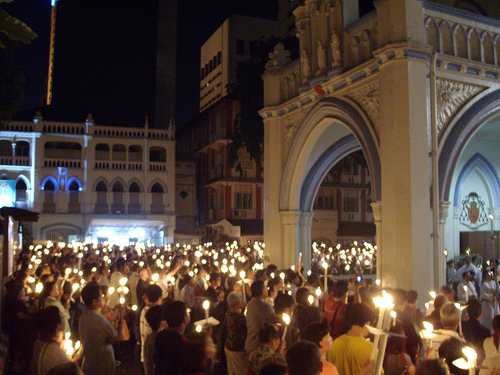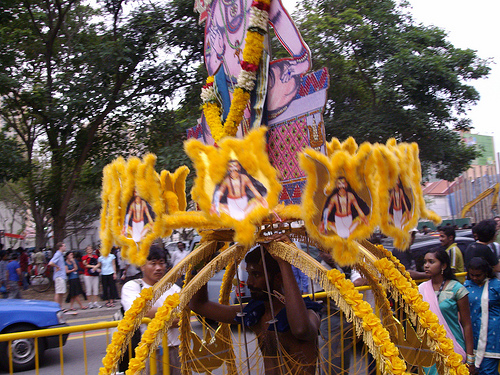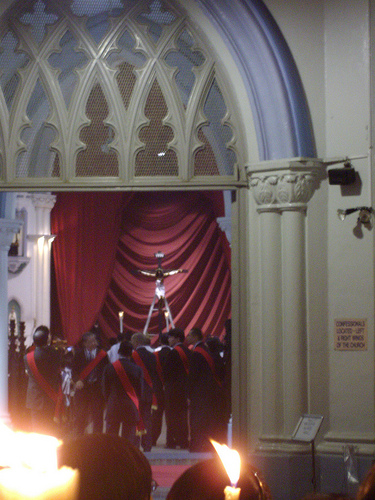I listened in on a Good Friday service in St Joseph’s church in Singapore last night, while standing amidst hundreds of others holding magic or holy candles, and during the reading of the Gospel of John’s passion narrative I was struck to suddenly hear echoes of thematic details also found in the apocryphal Gospel of Peter.
Now the Gospel of Peter is generally taken to have been written after the Gospel of John, but some have dated the Gospel of John towards the middle of the second century, and others have dated the Gospel of Peter to around the same period. What is a more tenable scenario, however, is that the “traditions” behind the Gospel of Peter do go back quite early. (See various online sources, including Wikipedia.)
I have compiled a comparative table of the Gospel of Peter with the canonical gospels.
Most of my argument assumes a late (very late – second century) dating of the gospels. I believe I can defend this view, and argue that most (not all) earlier datings rest more on apologetic assumptions and interpretations than hard evidence.
The common explanation for the variant view that Herod crucified Jesus is that it was an outgrowth of rising anti-semitism. That may be true. But there might also be another explanation – that the Herod story was the original one, and a more complex narrative involving Roman involvement was a later evolution. Either model will do — my views of rival narratives do not rely on either one.
One of the most significant differences is that in the Gospel of Peter it is Herod, the King of the Jews, who orders the crucifixion of Jesus, not the Roman Pilate. Pilate is clearly narrated as leaving Herod to carry out this deed. It is Jewish guards, not Roman soldiers, who do the dirty work. The same narrative appears to be in the mind of the Christian author who wrote the vision in The Ascension of Isaiah
And after this the adversary envied him and roused the children of Israel against him, not knowing who he was, and they delivered him to the king [presumably Herod], and crucified him. . . . (Ascension 11:19)
Justin Martyr, a church father who spent much time in the eastern churches (Syria, Samaria. . . ), who wrote about the middle of the second century, also believed it was Herod, not Pilate, who crucified Jesus. See my comparative table of Justin and the canonical and apocryphal gospels for details.
We also have the Slavonic Josephus with a Christian insertion that must be traced back to an eastern tradition that Pilate was bribed by the Jews (with 30 pieces of silver) to hand Jesus over to them for execution.
The teachers of the Law were [therefore] envenomed with envy and gave thirty talents to Pilate, in order that he should put him to death. And he, after he had taken [the money], gave them consent that they should themselves carry out their purpose. And they took him and crucified him according to the ancestral law.
See my earlier blog post Gospel of Peter and the Slavonic Josephus for discussion.
The Acts of Peter, from Asia Minor, may be assuming a similar narrative when we read:
Thou didst harden the heart of Herod . . . . thou didst give boldness unto Caiaphas, that he should deliver our Lord Jesus Christ unto the unrighteous multitude (Acts Peter VIII)
Eastern and Western rival narratives?
Was it an eastern “gospel tradition” that it was “the Jews” under their king Herod who crucified Jesus? Was the gospel tradition that became canonical, that Pilate killed Jesus, of western (Roman?) derivation? Was the eastern tradition expanded by what became the canonical gospel “tradition”, with the gospels of Mark and (canonical) Luke being western, even Roman, in origin? The Gospel of Matthew, I think, also assumed prominent status among western theologians. And was not John’s gospel on the cusp of the two — being traced to Asia Minor centres that were crossroads of dialogue between east and west?
Both the Gospels of John and Peter place heavy emphasis on the culpability of the Jews as Jews for the death of Jesus. “The Jews” are addressed as a race apart from Jesus.
Both the Gospels of John and Peter place extra heavy emphasis on Jesus’ death being the fulfilment of scriptures. (All the gospels do this to lesser and greater extents, but this trope is given particular emphasis in these two gospels, I think.)
But the alarm started ringing when I heard in the reading Pilate twice attempting to pass Jesus back to the Jews for punishment, with each attempt proving to be a narrative foil to explain why it really was Pilate, and not the Jews, who took over the role of crucifying Pilate.
Then Pilate said to them, “You take him and judge him according to your law.” Therefore the Jews said to him, “It is not lawful for us to put anyone to death.” (John 18:31)
Therefore, when the chief priests and officers saw him, they cried out, saying, “Crucify him, crucify him!” Pilate said to them, “You take him and crucify him, for I find no fault in him.” The Jews answered him, “We have a law, and according to our law he ought to die, because he made himself the Son of God.” Therefore when Pilate heard that saying he was the more afraid, and went again into the Praetorium. . . (John 19:6-9)
Why does “John” introduce these exchanges? Is he attempting to rebut an alternative gospel tradition that it was indeed the Jews who crucified Christ?
Is he attempting to tackle head on what the Gospel of Mark had attempted to dismiss with a sideways glance? GMark told a story that while Herod (or Herodians) had sought to kill Jesus, Jesus eluded them.
Then the Pharisees went out and immediately plotted with the Herodians against [Jesus], how they might destroy him. But Jesus withdrew with his disciples to the sea. (Mark 3:6-7)
The Gospel of Luke (which in its canonical form I often suspect is later than the other three gospels) addresses the issue with a revised narrative insert that might appear to explain how the confusion arose in the first place:
When Pilate heard of Galilee, he asked whether the man were a Galilaean. And as soon as he knew that he belonged unto Herod’s jurisdiction, he sent him to Herod, who himself also was at Jerusalem at that time. And when Herod saw Jesus, he was exceeding glad: for he was desirous to see him of a long season, because he had heard many things of him; and he hoped to have seen some miracle done by him. Then he questioned with him in many words; but he answered him nothing. And the chief priests and scribes stood and vehemently accused him. And Herod with his men of war set him at nought, and mocked him, and arrayed him in a gorgeous robe, and sent him again to Pilate. And the same day Pilate and Herod were made friends together: for before they were at enmity between themselves. (Luke 23:6-12)
The advantage of the Pilate narrative?
If this was the case, and there was a rival narrative in which the Jews, led by their King and High Priest, crucified Jesus, how might we account for the eventual takeover by the canonical version?
One answer may be alluded to in another post of mine in which I discussed thoughts arising from two strange bedfellows: John Carroll’s The Existential Jesus and Michael Patella’s The Lord of the Cosmos. See Pilate and the Cosmic Order in Mark.
The canonical narrative with its complex interrelationship of Jewish and Roman court hearings is certainly a more sophisticated structure than the more direct linear tale of Herod killing Jesus. This alone might reasonably suggest it was of later origin. Add to this the apparent references in Mark, Luke and John (cited above) that appear to be in dialogue with another tradition. But we can’t be sure.
I would think that the canonical version involving Rome had the long-term sustainable advantage of bringing into the myth the notion of Jesus’ death being linked to a new cosmic order on earth (not just in heaven), and involved the spiritual overthrow of all earthly powers. Pilate, as the representative of Rome, and the close involvement of the Roman soldiers in his death, alongside Jewish culpability, broadened the message of the gospel into a well, more “catholic” one. It was more than an anti-semitic diatribe. Pilate’s reluctance, the centurion’s recognition of Jesus, the soldier’s role in opening up another “sign” of Jesus by piercing his side, — these introduced somewhat relatively more neutral (merely doing the job, not motivated by envy like the Jews) and “ready to be converted” non-Jews into a central gospel role.
The role of Rome also gave the gospel a clearer focus on “the cosmos”, the world, represented by Rome, and its leading role that emerged through the second century.
Besides, the gospels of Matthew and John preserved enough that was of value for anti-semitic fodder without the need for the blunter Gospel of Peter.






